How To Play League of Legends,
The Biggest Game In The World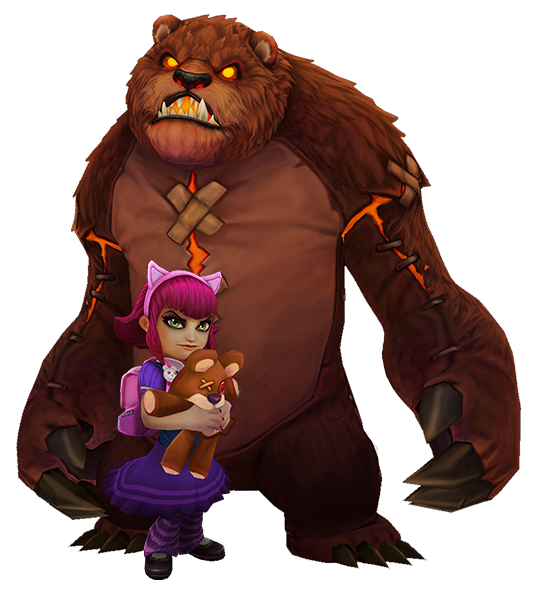
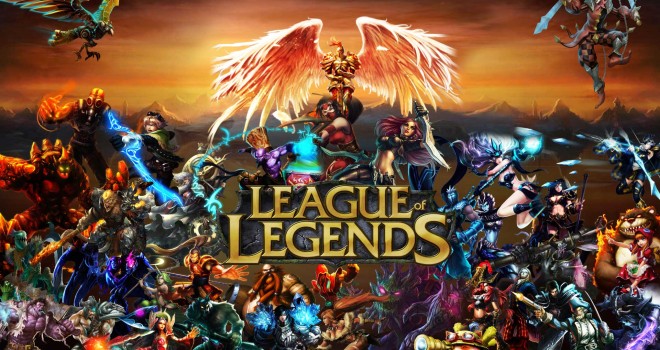
League of Legends (
LoL) is a
multiplayer online battle arena video game developed and published by
Riot Games for
Microsoft Windows and
Mac OS X, inspired by the
mod Defense of the Ancients for the video game
Warcraft III: The Frozen Throne. It is a
free-to-play game, supported by micro-transactions. It was first announced on October 7, 2008, and released on October 27, 2009.
League of Legends was generally well received at release, and has grown in popularity in the years since. According to a 2012
Forbes article,
League of Legends is the most played PC game in the world in terms of the number of hours played.
Download League of Legends Download the game and run the League of Legends installer to continue!
Download the game and run the League of Legends installer to continue! GameplayLeague of Legends is a
multiplayer online battle arena where players take control of a character called a champion, and are matched with and against other players in teams. As of December 13, 2013, there are 117 different Champions from which to choose from. Players meet up usually in "lanes", and gain levels from killing the opposing team's Champions controlled by players and Minions that regularly
spawn and attack the other team. The player earns a small amount of gold pa**ively, but gets more by killing minions, towers that guard the lanes, and neutral monsters. With this gold, they can buy items to strengthen their champion for the duration of the game. On the cla**ic Summoners Rift map, the game is ended by destroying the last structure on the map, the enemies' "Nexus". Other maps have variations of rules and objectives, such as Dominion where the team's Nexus will lose health when the opposing team has at least three of the five towers in their control.
The player is personified as a "Summoner" and acts as the persistent element in the game, to be used to track statistics and scores for each player. Summoners gain
experience points and "Influence Points" (in-game currency) for each battle they participate in. Experience points lead to persistent level gains for the Summoner, up to a maximum level of 30. The benefit of gaining levels is unlocking Mastery Points and Rune Page slots (below) which improve the overall strength of the Summoner's chosen champion in-game. The Summoner can also choose two summoner spells. These spells significantly impact gameplay, and have a high cooldown while costing no mana. All spells can be improved by masteries, which are developed in a
skill tree. Masteries are
perks that affect gameplay, structured in a
skill tree. All of the masteries are pa**ive effects, although some augment summoner spells, which can be activated. They are grouped into Offensive, Defensive, and Utility categories. Masteries can be re-distributed at will between battles.
Similar to masteries, runes affect gameplay in minor ways. Runes are categorized into Marks (offensive), Seals (defensive), Glyphs (magic) and Quintessences (utility). Runes must be unlocked in the Store and it is possible to have more than one copy of a rune. Summoners must arrange their runes in the Runebook to benefit from them. The Runebook has limited number of slots for each rune type, but more rune pages can be purchased from either Influence Points or Riot Points. Combining two equal-tier runes produces a random rune of the same tier, while combining 5 equal-tier runes produces a higher-tier rune.
The League of Legends Store allows Summoners to purchase additional options through Riot Points (RP) and Influence Points (IP). Riot Points must be bought using real money, while Influence Points are earned by playing the game.
Moderation is conducted through a democratic system known as The Tribunal. In this system, player-submitted reports are reviewed by other players on a case-by-case basis. The reviewing players then submit their opinions on the legality of the behavior demonstrated. A consensus renders the decision official. It is notable that players are unable to be permanently banned through this system, since "all permanent bans are distributed manually." Reviewers receive a Justice Rating based on their accuracy to encourage thorough analysis of cases.
Game modes and matchmakingLeague of Legends is a session-based game. Matchmaking creates teams with even average MMR (Matchmaking Rating) of the constituent players. MMR uses the
Elo formula with proprietary adjustments.
- Tutorial mode is a set of two introductory games that teach the basics. It is intended to help new players learn important concepts, which might not otherwise be obvious.
- Custom mode allows players to create games that players opt into rather than relying on matchmaking to create the teams. In custom matches, the teams can be uneven (for example, 3v4 or 2v5) and may include a mix of players and bots, which are computer-controlled champions.
- Co-op vs. AI mode matches players against a team of bots. Similar to the Tutorial mode, it is also intended mainly as a way for inexperienced players to learn, but it also used by more experienced players as a way of experimenting with new ideas or getting an easy First Win of the Day.
- Normal matches are player vs player, and has either Blind Pick where both teams can pick whatever champions they want all at the same time, or Draft Pick where a randomly a**igned team captain chooses three bans to disallow the enemy from playing those champions, and then players choose their champions in an ordered format. After champions are all chosen, players may trade with each other, allowing for players to pick for each other for strategic effect.
- Ranked mode is available to players that are level 30. Ranked uses the Draft Pick system exclusively, and players are seeded into a League system based on the outcome of their matches.
- Random mode randomly picks champions that the players are able to play, allowing up to 2 re-rolls if the player is unsatisfied with their pick, and also may trade with others if both parties own the champions to be traded.
Minimum System Requirements (PC)The following are the minimum and recommended system requirements for running League of Legends on a PC:
Minimum System Requirements:
2 GHz processor
1 GB RAM (Windows Vista and 7 users will want 2 GB of RAM or more)
8 GB available hard disk spaceShader version 2.0 capable video cardSupport for DirectX v9.0c or betterWindows XP, Windows Vista, or Windows 7. (Mac Minimum System Requirements can be found here: https://support.leagueoflegends.com/entries/23260481-Mac-Minimum-System-Requirements)
Recommended System Requirements
3 GHz processor
2 GB of RAM (Windows Vista and 7 users should use 4 GB of RAM or more.)
12 GB available hard disk spaceGeForce 8800 or equivalent video card (Dedicated GPU with 512MB+ Video Memory(VRAM))Support for DirectX v9.0c or better.Windows XP with the latest service pack installed, Windows Vista with the latest service pack installed, or Windows 7 The latest update to .NET Framework from Microsoft The latest version of Adobe Air is required to connect to PVP.net. Adobe Air is included with all League of Legends setup files, but can also be downloaded from
Adobe's website.
Getting Started on Summoner's RiftA lot goes into a successful battle on the Field of Justice. Here you'll learn about the basics of the game, familiarize yourself with the basic mechanics through the in-game tutorials, and take your first steps onto Summoner's Rift.
Champions
The League is filled with champions of every archetype, from devious masterminds to epic monsters and everything in between. Different champions suit different roles and strategies, so don't get discouraged if the first one you try doesn't mesh with your playstyle.
See a full list of championsControlling your champion
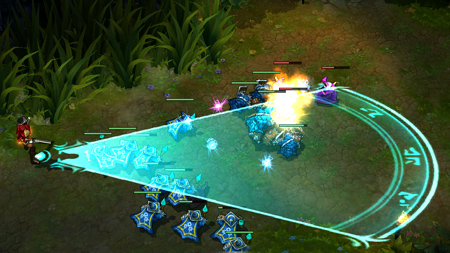
With a few caveats, champions use a traditional RTS control scheme.
- To move your champion, right click on the terrain where you'd like to go
- To attack an enemy, right click on your target
- To cast a spell left-click the a**ociated icon or use the spell's hotkey (Q,W,E, or R by default), and then click on the target.
Controls can be customized through the Options menu.
Lanes
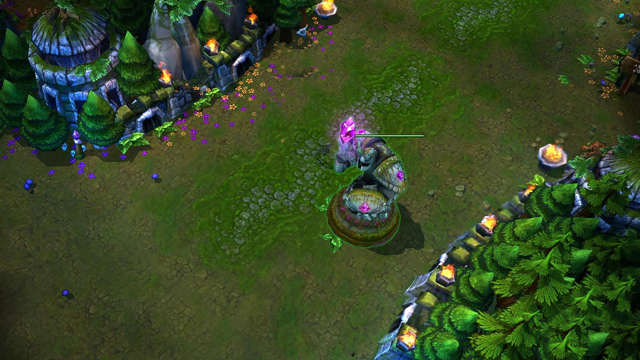
There are three roads that connect your base to the enemy's. These roads are called lanes, and they'll serve as the means of engaging the enemy team. To win a game you'll have to push down your lane into the enemy base and destroy the nexus at the heart of their base.
Minions

Minions are AI-controlled soldiers that spawn at the nexus and march down each lane toward the enemy base, attacking enemies they encounter along the way. Scoring the killing blow on a minion earns valuable gold for your champion. Minions prefer to fight each other, but will attack your champion if they find him alone in lane. They'll also switch targets to focus on you if you attack a nearby allied champion. Don't underestimate the power of a big wave of minions, particularly early in the game!
Turrets
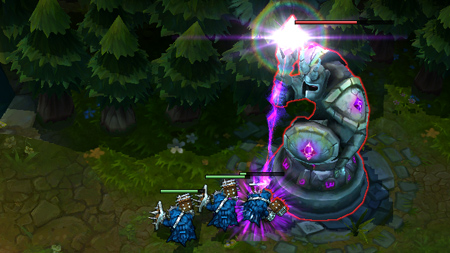
Turrets are powerful defensive structures that defend each lane at even intervals, punishing enemies that come within range with deadly bolts of energy. Like minions, they prefer to attack targets other than you, unless you engage another champion while within range. A hostile turret will only target you if you're attacking an enemy champion or if you're the last target in range. Beware of picking a fight under an enemy turret.
Inhibitors
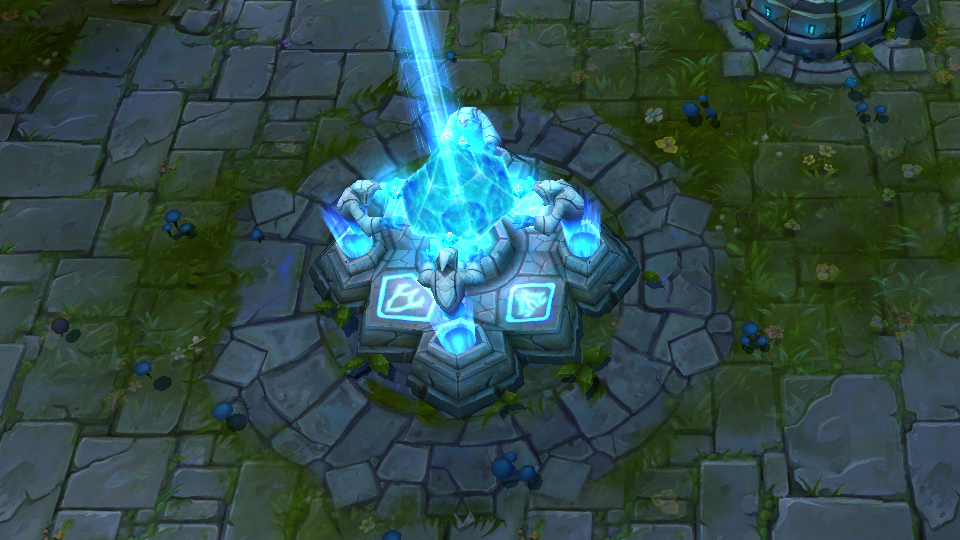
Important structures known as inhibitors are located where each lane meets the base on both sides of the map. Destroying an inhibitor creates a powerful super minion each time a new minion wave spawns in that lane. Super minions are extremely durable, making them ideal for leading the charge on the enemy nexus. Inhibitors respawn after five minutes, so be sure to press your advantage during this time.
Destroying all three of an enemy's inhibitors will cause two super minions to spawn in each lane every time a new minion wave is created.
The Nexus

At the heart of each base lies the nexus. Protected by two turrets, the nexus is the structure that periodically generates minion waves in each lane. Once a team has destroyed the enemy nexus, the game is over and that team is declared victorious.
Items

In a game of League of Legends, your champion earns gold by taking down enemy units and structures. Scoring the killing blow on a minion or champion, a**isting in a champion kill, and acquiring certain runes or items are just a few ways you can generate additional income. You can use your gold to purchase powerful items from the shop near the summoner platform. Just click on the shop or the button next to your gold total to open the store.
- Items grant bonuses as soon as they're purchased; there is no need to equip items
- Different champions and play styles excel with different item builds, so your strategy will inform your purchases
- The most powerful items are made by combining smaller items, so don't hesitate to buy a component item
- Usable equipment such as potions, wards, and activatable items are used by clicking on the icon in your inventory or by hotkey 1 - 6
The Jungle

Between the lanes lies the jungle, an expanse filled with neutral monsters. These monsters won't attack the enemy base, but they can be defeated for additional gold and special temporary buffs. A player may take on the role of jungler and use these areas as his primary source of income. Junglers typically roam between the lanes, coming to the aid of allies in lane when needed.
Helpful Links --
Ref: http://en.wikipedia.org/wiki/League_of_Legendshttp://gameinfo.na.leagueoflegends.com/en/game-info/get-started/new-player-guide/https://support.leagueoflegends.com/entries/234272-system-requirements

